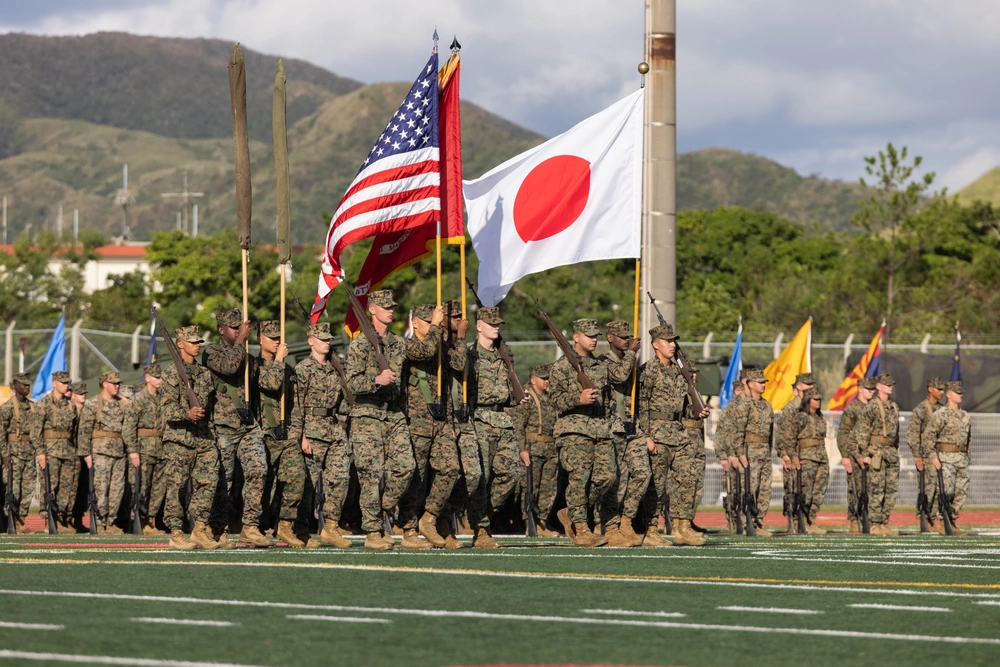U.S. 3rd Fleet Hosts RIMPAC Mid-Planning Conference

Release from U.S. 3rd Fleet Public Affairs
*****
Dec. 6, 2023
KANEOHE BAY, Hawaii – Commander, U.S. 3rd Fleet unveiled the new Rim of the Pacific 2024 logo at the kick-off of the middle planning conference for the exercise at Marine Corps Base Hawaii Dec. 5, 2023.
More than 800 personnel from representing nations participating in RIMPAC 2024 were in attendance to view the official logo before it was displayed to the public.
Of the 47 highly competitive entries from around the world, the final design was a combination of two separate submissions – one from Lt. Tristan Robertson of the Royal Canadian Navy and one from Lt. Emily Paiz of the U.S Navy.
“The logo for RIMPAC represents the progress that has been made since the inception of the first exercise back in 1971,” said U.S. 3rd Fleet Deputy Commander Capt. Richard Meyer. “The design reflects the development of new and longstanding relationships while also highlighting the versatility in training that is a direct result of having a joint exercise of this scale.”
The RIMPAC 2024 theme “Partners: Integrated and Prepared” was the inspiration behind the creation of the logo. The creators wanted the logo to convey that RIMPAC is not just an exercise designed to bring multiple nations together, but also an event that allows its participants the opportunity to develop the relationships and partnerships required to meet the needs of each nation’s training and interoperability objectives.
“There has been tremendous growth with partnerships among nations,” said RIMPAC coordinator Royal Australian Navy Lt. Cmdr. Timothy Gill. “We continue to have more nations who want to join, want to train with us, and also want to train with all nations as a unit. We are all focused on the same goal of maritime safety and security.”
Unlike the previous RIMPAC, the entire exercise will solely take place in and around the Hawaiian Islands. To commemorate that, the backdrop of the logo features a tropical landscape. At the center of the logo is a trident that is representative of both U.S. 3rd Fleet and the joint warfighting capabilities of land, air and sea.
The logo was revealed at beginning of the mid-planning conference for RIMPAC 2024, a biennial event that allows participants from all partner nations to conduct detailed exercise planning, synchronize all aspects of the exercise, including harbor, force integration and tactical phases, and review draft schedules of events.
“I anticipate that this RIMPAC will be more dynamic than previous iterations, and will provide increased opportunities for all participating nations to work together as an integrated and interchangeable force,” said Meyer. “While its focus on the maritime remains, the scale and scope of RIMPAC has grown and evolved over the years into a true multi-domain exercise. We see particular growth in the air and land domains. In keeping with the updated RIMPAC theme, vision and objective, RIMPAC 2024 will mark a notable advancement in the history of the exercise.”
The world’s largest international maritime exercise, RIMPAC provides a unique training opportunity while fostering and sustaining cooperative relationships among participants critical to ensuring the safety of sea lanes and security on the world’s oceans.
RIMPAC 2024 is the 29th exercise in the series that began in 1971 and was held annually until 1974, when it became a biennial exercise due to its increasing scale. The founding nations were Australia, Canada and the United States.







